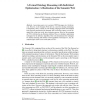180 search results - page 12 / 36 » Certain answers as objects and knowledge |
NN
2002
Springer
13 years 7 months ago
2002
Springer
Recognition-by-components is one of the possible strategies proposed for object recognition by the brain, but little is known about the low-level mechanism by which the parts of o...
CLUSTER
2008
IEEE
13 years 7 months ago
2008
IEEE
Service providers and their customers agree on certain quality of service guarantees through Service Level Agreements (SLA). An SLA contains one or more Service Level Objectives (S...
32
Voted
3DOR
2010
13 years 2 months ago
2010
While approaches based on local features play a more and more important role for 3D shape retrieval, the problems of feature selection and similarity measurement between sets of l...
WISE
2005
Springer
14 years 1 months ago
2005
Springer
Abstract. Answering a query over a group of RDF data pages is a trivial process. However, in the Semantic Web, there is a need for ontology technology. Consequently, OWL, a family ...
COMPSAC
2007
IEEE
14 years 1 months ago
2007
IEEE
Personnel risk is an issue which has not been researched well but plays an important role to determine whether a software project succeeds or fails. Most existing work focuses on ...

